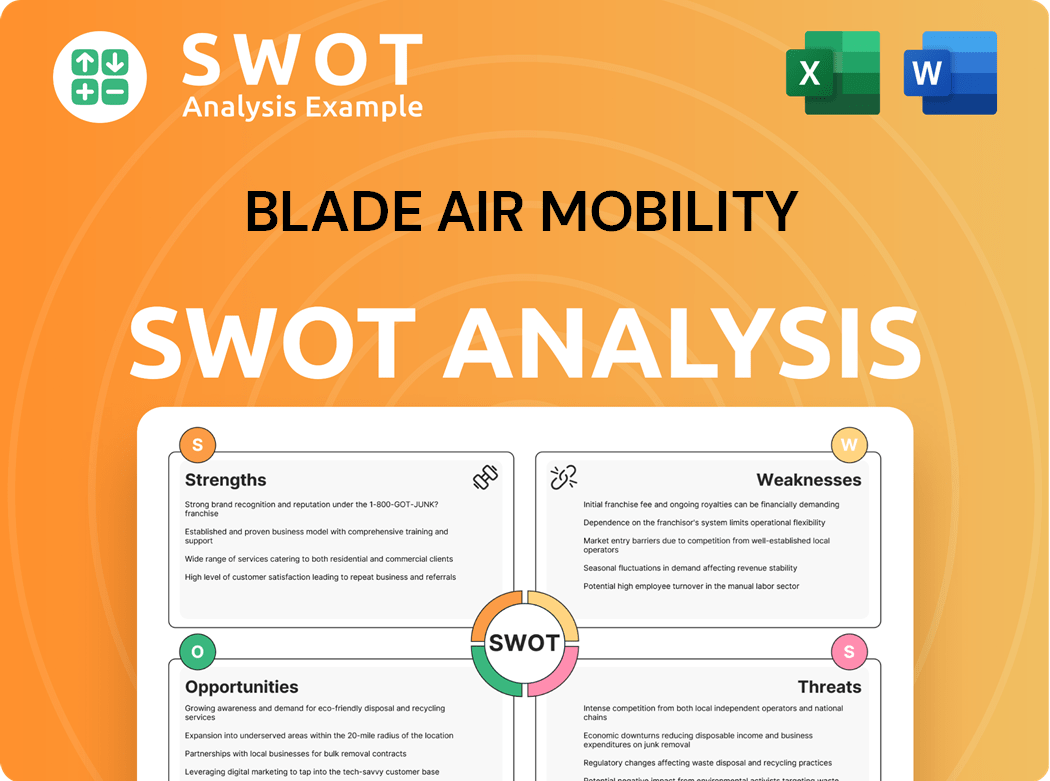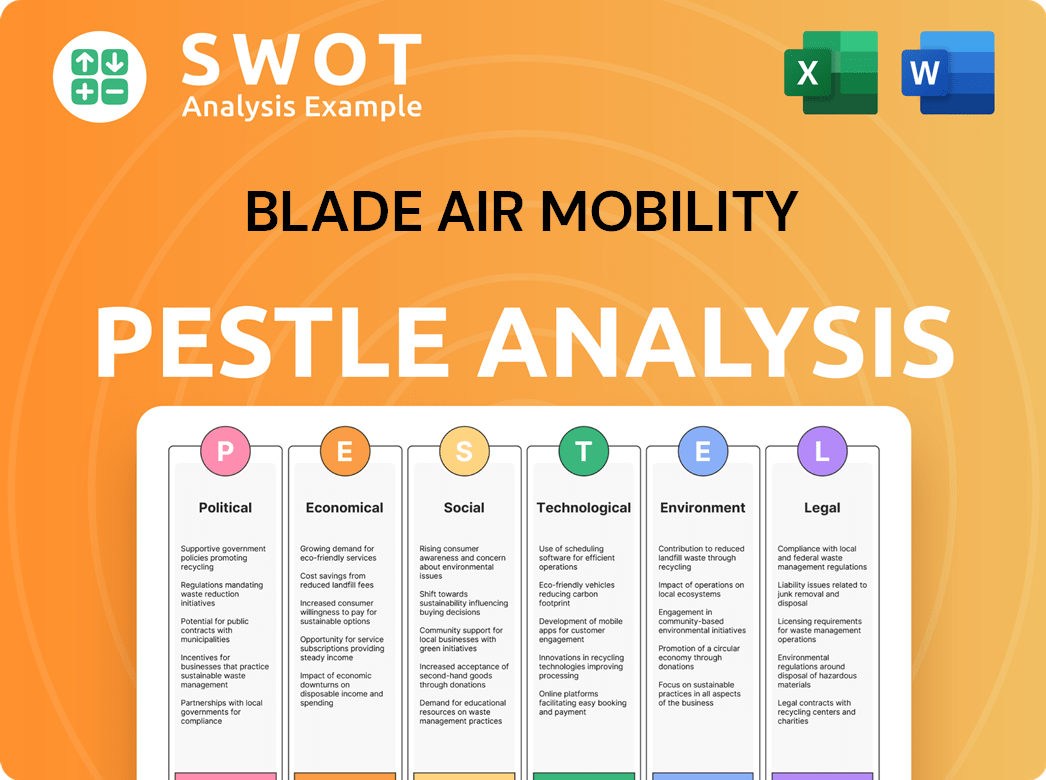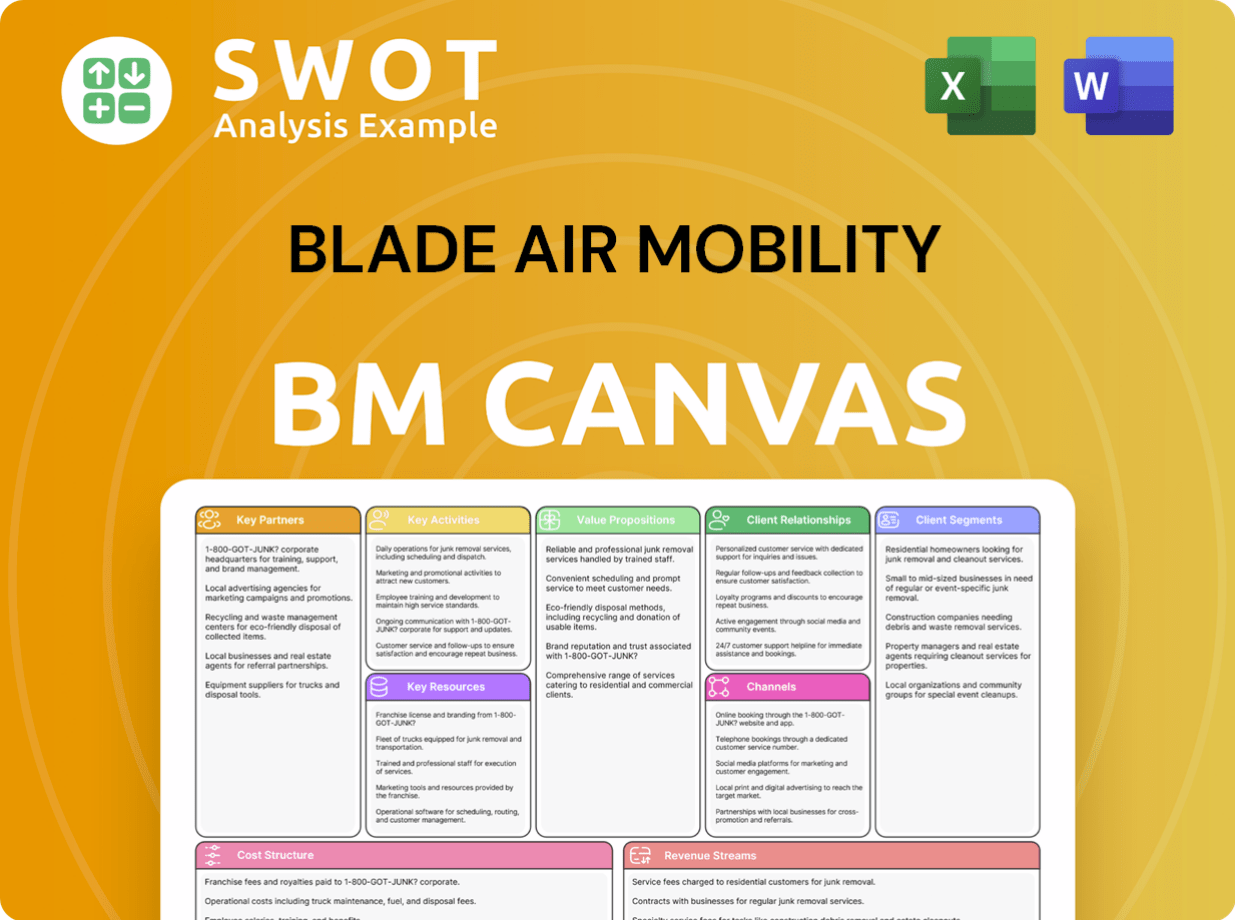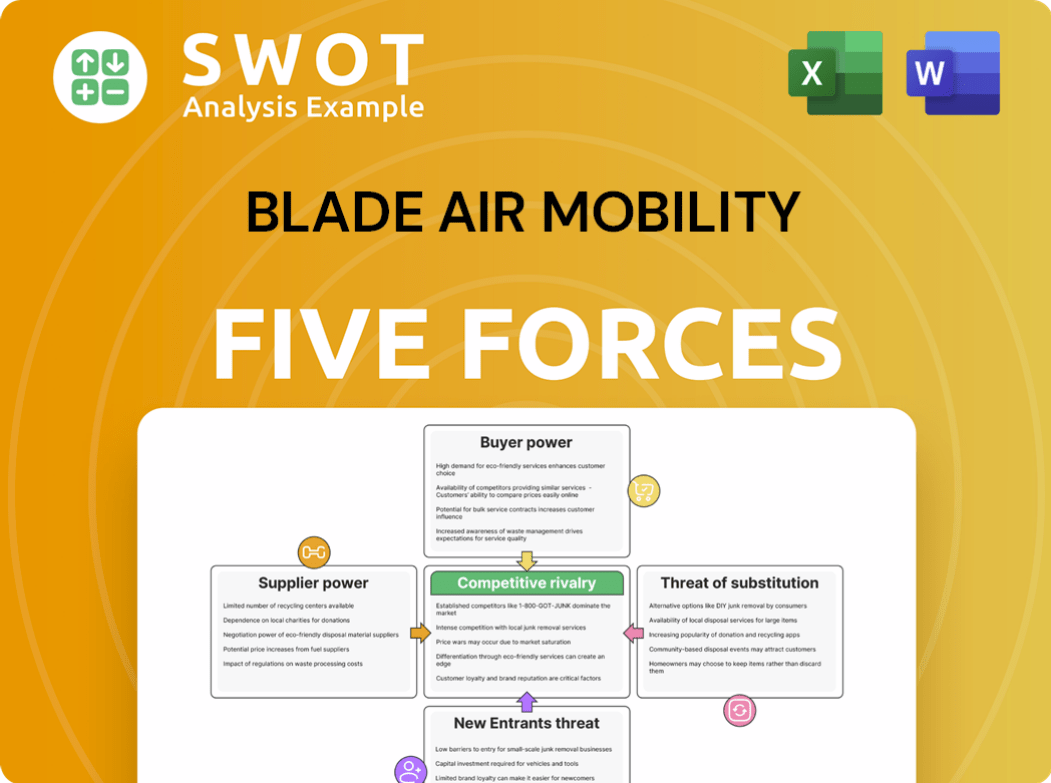Blade Air Mobility Bundle
How Did Blade Air Mobility Take Flight?
Blade Air Mobility has revolutionized short-distance travel, emerging as a pivotal force in the burgeoning urban air mobility (UAM) sector. Initially focusing on helicopter and fixed-wing flights, the company swiftly established itself as a leader in providing efficient alternatives to traditional ground transportation. This innovative approach, which started by leveraging existing aviation infrastructure, quickly resonated within congested urban environments and popular leisure destinations, offering a convenient air taxi service.

From its inception, Blade Air Mobility recognized the potential to make air travel accessible beyond the ultra-wealthy, building a platform that connects travelers with available aircraft. Blade Air Mobility SWOT Analysis reveals the company's strategic moves. As of early 2025, Blade continues to expand its services and invest in future electric vertical aircraft (EVA) operations. This exploration dives into the Blade company history, its growth trajectory, and its forward-looking strategies, aiming to reshape the future of short-haul air travel, including Blade helicopter service and Blade airport transfer options.
What is the Blade Air Mobility Founding Story?
The story of Blade Air Mobility began on May 28, 2014. The company was founded by Robert S. Wiesenthal and Steve Martello. They saw an opportunity to transform short-distance travel using underutilized aviation capacity.
Wiesenthal's background in media and finance, combined with Martello's tech expertise, set the stage for a new approach to urban transportation. Their initial focus was on solving the time-consuming challenges of ground travel, particularly for routes where air travel could offer a significant advantage. This marked the beginning of what would become a prominent player in the urban air mobility sector.
The early business model of Blade Air Mobility, often described as an 'Uber for helicopters,' was asset-light. The company didn't own aircraft. Instead, it connected passengers with operators through its technology platform. The inaugural service was scheduled helicopter flights between Manhattan and the Hamptons, a route known for its traffic delays. This service quickly gained popularity, highlighting the convenience and time savings offered by the Blade helicopter service.
Blade's early success was driven by its innovative approach to air travel and strategic partnerships.
- Founders: Robert S. Wiesenthal and Steve Martello.
- Date of Founding: May 28, 2014.
- Initial Focus: Helicopter flights between Manhattan and the Hamptons.
- Business Model: Asset-light, connecting passengers with operators.
- Funding: Seed rounds and strategic investors.
The name 'Blade' was chosen to immediately communicate its core service, evoking the image of helicopter rotors. Initial funding came from seed rounds and strategic investors. The founders' combined expertise in technology, finance, and logistics proved crucial. It helped navigate the complex aviation regulations and build a scalable platform. For more details on the company's ownership structure, you can read about Owners & Shareholders of Blade Air Mobility.
Blade Air Mobility SWOT Analysis
- Complete SWOT Breakdown
- Fully Customizable
- Editable in Excel & Word
- Professional Formatting
- Investor-Ready Format

What Drove the Early Growth of Blade Air Mobility?
The early growth of Blade Air Mobility was marked by rapid expansion, capitalizing on the demand for convenient transportation options. Starting with its successful Hamptons routes, the company quickly scaled its Blade helicopter service to other major metropolitan areas. This expansion was fueled by strong user demand, appreciating the time savings and convenience offered by the service. Blade's asset-light approach enabled agile growth.
Following its initial success, Blade Air Mobility expanded its services to key markets like New York City (JFK and Newark airports), Los Angeles, and Miami. This expansion strategy focused on high-demand, congested corridors where the time savings offered by the Blade airport transfer were most valuable. The company's ability to quickly establish routes and adapt to market demands was a key factor in its early success. The company's early focus was on urban air mobility, aiming to provide an air taxi service to customers.
Blade expanded its offerings beyond scheduled flights to include on-demand charter services, broadening its appeal. In 2017, the company launched Blade Jet. Strategic partnerships with existing aviation operators were essential for expanding flight availability and maintaining service quality. These partnerships were crucial for Blade's operational capabilities and its ability to scale its services efficiently. For more information on the competitive landscape, see the Competitors Landscape of Blade Air Mobility.
Early customer acquisition strategies centered on digital marketing and partnerships with luxury brands, targeting a demographic willing to pay a premium for expedited travel. The team grew significantly, with hires in technology, operations, and customer service to support the expanding network. By early 2020, Blade had established a strong presence in its target markets, demonstrating consistent user growth and revenue milestones. This growth was supported by strategic investments in technology and operational infrastructure.
While specific financial figures for the early growth phase are not consistently available, the company's focus on premium services and high-value routes suggests a revenue model driven by high-yield flights. The consistent user growth and expansion into new markets indicate a positive market reception. The company's ability to adapt to user feedback and refine its service offerings was pivotal in shaping its trajectory during this early growth phase. The company's early success set the stage for future developments.
Blade Air Mobility PESTLE Analysis
- Covers All 6 PESTLE Categories
- No Research Needed – Save Hours of Work
- Built by Experts, Trusted by Consultants
- Instant Download, Ready to Use
- 100% Editable, Fully Customizable

What are the key Milestones in Blade Air Mobility history?
Blade Air Mobility has achieved several significant milestones, shaping its journey in the urban air mobility sector. A key achievement was its NASDAQ listing in May 2021 through a SPAC merger, which valued the company at approximately $825 million. This strategic move provided substantial capital for expansion and technological advancements, marking a pivotal moment in the Blade company history.
| Year | Milestone |
|---|---|
| 2014 | Founded as a helicopter service, offering on-demand flights. |
| 2019 | Expanded services to include airport transfer and other urban routes. |
| 2021 | Listed on NASDAQ through a SPAC merger, raising significant capital. |
| 2022 | Announced partnerships for electric vertical aircraft (EVA) development. |
| 2023 | Continued expansion of vertiport infrastructure and strategic partnerships. |
Blade Air Mobility has been at the forefront of innovation in the urban air mobility space. Their focus on developing infrastructure for electric vertical aircraft (EVA) is a key area of innovation, preparing for the future of emission-free air travel. This includes securing strategic vertiport locations and partnerships for charging infrastructure.
Blade has developed a comprehensive platform that integrates various aircraft types and services, offering a seamless experience for passengers. This platform allows users to book flights, manage their travel, and access real-time information, enhancing the overall customer experience.
Blade is actively building infrastructure for electric vertical aircraft (EVA), including securing vertiport locations and establishing charging stations. This proactive approach positions Blade to capitalize on the growing demand for sustainable air travel solutions.
Collaborations with companies like BETA Technologies for electric aircraft and infrastructure development are a key innovation. These partnerships help Blade to mitigate risks and accelerate the transition to EVA technology, ensuring future growth.
Blade prioritizes customer experience through convenient booking, efficient airport transfers, and premium services. This customer-centric approach has helped Blade build a strong brand reputation and customer loyalty.
Blade integrates advanced technologies to enhance its services, including real-time flight tracking, automated booking systems, and data analytics for route optimization. This technological integration improves operational efficiency and customer satisfaction.
Blade continuously expands its service offerings, including airport transfers, city-to-city flights, and medical transport. This expansion allows Blade to cater to a wider range of customer needs and increase revenue streams.
Despite its advancements, Blade Air Mobility faces challenges inherent in the aviation industry. The highly regulated nature of aviation and the complexities of urban airspace present ongoing hurdles for the company. Market downturns and economic uncertainties can impact discretionary travel, affecting the demand for premium air services.
Navigating the complex regulatory landscape of the aviation industry, including FAA approvals and safety standards, poses a significant challenge. Compliance with these regulations is essential for operating safely and legally.
Managing operations within the congested urban airspace, including air traffic control and route optimization, presents operational challenges. This requires careful planning and coordination to ensure safe and efficient flights.
Economic downturns can reduce demand for premium air services, impacting Blade's revenue and profitability. The company's financial performance is sensitive to fluctuations in the economy and consumer spending.
The transition to electric vertical aircraft (EVA) involves technological hurdles, including battery performance, charging infrastructure, and air traffic management systems. Overcoming these challenges is critical for the future of urban air mobility.
Blade faces competition from other air taxi services and traditional transportation options. Differentiating its services and maintaining a competitive edge is essential for long-term success in the market.
Developing and maintaining the necessary infrastructure, including vertiports and charging stations, requires significant investment and strategic planning. Securing suitable locations and managing construction costs are ongoing challenges.
Blade Air Mobility Business Model Canvas
- Complete 9-Block Business Model Canvas
- Effortlessly Communicate Your Business Strategy
- Investor-Ready BMC Format
- 100% Editable and Customizable
- Clear and Structured Layout

What is the Timeline of Key Events for Blade Air Mobility?
The Revenue Streams & Business Model of Blade Air Mobility has seen significant milestones since its inception. Initially focused on helicopter services, the company expanded its offerings and geographic reach, adapting to market challenges and technological advancements. From launching in 2014, to its expansion on both coasts, and its shift to public trading in 2021, the company has consistently aimed to enhance urban air mobility.
| Year | Key Event |
|---|---|
| 2014 | Founded by Robert S. Wiesenthal and Steve Martello. |
| 2015 | Launched initial scheduled Blade helicopter service between Manhattan and the Hamptons. |
| 2017 | Introduced Blade Jet service, expanding into fixed-wing operations. |
| 2019 | Expanded services to the West Coast, starting with routes in California. |
| 2020 | Faced initial challenges due to the COVID-19 pandemic's impact on travel but adapted by focusing on essential services. |
| 2021 | Became a publicly traded company on NASDAQ (BLDE) through a SPAC merger. |
| 2022 | Announced significant infrastructure investments and partnerships for future EVA operations. |
| 2023 | Continued expansion of medical organ transport services, a key growth area. |
| 2024 | Reported a 29% increase in total flight revenue to $60.2 million for the year ended December 31, 2023, reflecting strong operational performance and growing demand. |
| 2025 | Anticipated further expansion of its European operations and continued development of its EVA infrastructure. |
Blade is strategically focused on transitioning to electric vertical aircraft (EVA). This shift positions the company to be a leader in the next generation of urban air mobility. The transition leverages the company's existing infrastructure and operational expertise to capitalize on the growing market for sustainable air travel solutions.
Key initiatives include expanding the network of vertiports and forging deeper partnerships with EVA manufacturers. The company continues to grow its medical organ transport business. This segment provides a stable and high-margin revenue stream, contributing to the overall financial performance and future outlook of Blade Air Mobility.
Increasing urbanization and the demand for faster and more sustainable transportation solutions are major market trends. These trends are expected to significantly impact Blade's future. Analysts predict continued growth in the air taxi service market, with companies like Blade well-positioned to capitalize on this expansion.
The company's leadership consistently emphasizes a commitment to providing a seamless, efficient, and sustainable air travel experience. The forward-looking strategy remains rooted in making air travel more accessible and efficient for short-distance journeys. The company plans to evolve with technological advancements to achieve this goal.
Blade Air Mobility Porter's Five Forces Analysis
- Covers All 5 Competitive Forces in Detail
- Structured for Consultants, Students, and Founders
- 100% Editable in Microsoft Word & Excel
- Instant Digital Download – Use Immediately
- Compatible with Mac & PC – Fully Unlocked

Related Blogs
- What is Competitive Landscape of Blade Air Mobility Company?
- What is Growth Strategy and Future Prospects of Blade Air Mobility Company?
- How Does Blade Air Mobility Company Work?
- What is Sales and Marketing Strategy of Blade Air Mobility Company?
- What is Brief History of Blade Air Mobility Company?
- Who Owns Blade Air Mobility Company?
- What is Customer Demographics and Target Market of Blade Air Mobility Company?
Disclaimer
All information, articles, and product details provided on this website are for general informational and educational purposes only. We do not claim any ownership over, nor do we intend to infringe upon, any trademarks, copyrights, logos, brand names, or other intellectual property mentioned or depicted on this site. Such intellectual property remains the property of its respective owners, and any references here are made solely for identification or informational purposes, without implying any affiliation, endorsement, or partnership.
We make no representations or warranties, express or implied, regarding the accuracy, completeness, or suitability of any content or products presented. Nothing on this website should be construed as legal, tax, investment, financial, medical, or other professional advice. In addition, no part of this site—including articles or product references—constitutes a solicitation, recommendation, endorsement, advertisement, or offer to buy or sell any securities, franchises, or other financial instruments, particularly in jurisdictions where such activity would be unlawful.
All content is of a general nature and may not address the specific circumstances of any individual or entity. It is not a substitute for professional advice or services. Any actions you take based on the information provided here are strictly at your own risk. You accept full responsibility for any decisions or outcomes arising from your use of this website and agree to release us from any liability in connection with your use of, or reliance upon, the content or products found herein.